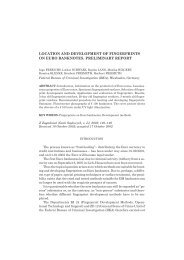Pobierz PDF - PROBLEMS OF FORENSIC SCIENCES
Pobierz PDF - PROBLEMS OF FORENSIC SCIENCES
Pobierz PDF - PROBLEMS OF FORENSIC SCIENCES
You also want an ePaper? Increase the reach of your titles
YUMPU automatically turns print PDFs into web optimized ePapers that Google loves.
424<br />
phenomenon. in his opinion projection is a more general<br />
mechanism for assigning meanings, whose range<br />
extends to include meanings that are significantly distorted.<br />
we may then formulate a definition of a projective<br />
technique: it is a diagnostic technique based on<br />
cognitive projection or apperception. to put it in the<br />
terms of contemporary psychology, the essence of the<br />
projective diagnosis is the use by those under examination<br />
of their own cognitive and affective structures<br />
(cognitive schemas) to assign individual meanings to<br />
ambiguous material. projective behaviour is then not<br />
an expression, as in speech, writing and drawing, but<br />
rather the diagnosed person’s interpretation of a projective<br />
stimulus with the specific structure presented<br />
to them during a diagnostic examination. leichtman<br />
[31, p. 304] draws attention to the social and communicative<br />
context of giving meaning to a projective<br />
stimulus, while Stasiakiewicz [55, p. 32] emphasises<br />
that one of the decisive factors in producing the quality<br />
of “projectivity” is the non-directive, unspecific<br />
nature of the task the diagnostician gives the person<br />
under examination and the way in which it is attuned<br />
to the individualisation and divergence of the expected<br />
diagnostic behaviour.<br />
in other words, when interpreting unclear and ambiguous<br />
projective stimuli we are dealing with projective<br />
reactions: creating a space of meanings and placing<br />
ourselves and others in it.<br />
the more poly-semantic and devoid of informative<br />
indicators this reality is, the more the attribution<br />
is individualised and psychologically meaningful (diagnostic)<br />
and the more the perception of this reality is<br />
an interpretation rather than a reflection. understood<br />
in this way, projection reveals not only the characteristics<br />
and mechanisms of an individual’s personality,<br />
but also the patterns of adaptation they actualise. this<br />
is a complex process involving the semantic transformation<br />
of a field of stimuli determined by a person’s<br />
individual characteristics, the semantic properties of<br />
the test material and the socio-cultural rules of semantisation.<br />
one of the tasks of the diagnostician may be<br />
to discriminate between the individual meanings and<br />
the everyday, cultural meanings that the majority of<br />
people have in common. it is on these grounds that<br />
conclusions are drawn, for example, on the complexity<br />
and other characteristics of the representation of<br />
people in a given person (tat interpretation in the<br />
ScoRS system [62, 63; see also 56]) or on the general<br />
level of adaptation (Rotter incomplete Sentences<br />
Blanks [26]).<br />
it should not be forgotten that the gradation of perception<br />
distortion Bellak [3] wrote of concerns typi-<br />
Problems of Forensic Sciences 2013, vol. 93, 421–437<br />
K. Stemplewska-Żakowicz, W. J. Paluchowski<br />
cal, everyday situations in which reality is a perceived<br />
stimulus rather than a projective stimulus specially<br />
constructed for diagnostic purposes. when using the<br />
projective method we develop projective test behaviours<br />
artificially, create ambiguous situations and design<br />
intentionally symbolic tasks with a poly-semantic<br />
content. there is therefore a far greater chance of<br />
observing disturbed perception during a “projective”<br />
examination, but this does not have to entail the high<br />
likelihood of their occurrence in real situations.<br />
Ruszczak [51, p. 119] writes that the originators<br />
of projective techniques were influenced in equal<br />
measure by psychophysics and psychoanalysis, which<br />
for contemporary psychology are branches of learning<br />
that have passed into history. Since it involves<br />
discriminating between the behaviour people exhibit<br />
and examining it to produce a description of the differences<br />
in subjective factors, which in turn enables<br />
each person’s individuality to be specified, the psychology<br />
of individual differences should also be cited<br />
as an influence. this is based on the elaboration of<br />
empirical taxonomies from behavioural differences in<br />
the belief that the taxonomical groups will have a subjective<br />
factor in common. in this way the measurement<br />
of variables treated as potential instances of the<br />
operationalization of theoretical factors was improved<br />
and a search was conducted for the correlates of the<br />
values of the variables measured. though significant<br />
achievements in selection were achieved thanks to this<br />
approach, its weakness lay in its neglect of theoretical<br />
foundations and in its insufficient precision. in short,<br />
reliability took precedence over accuracy. this resembles<br />
the position of a laboratory assistant who uses<br />
the most precise computerised apparatus to measure<br />
cholesterol, finds that the level exceeds the clinical<br />
norm and regards this as diagnosis. Yet only a doctor<br />
armed with medical knowledge is in a position to state<br />
what the indicator actually means: it is the theoretical<br />
knowledge that allows the diagnostician to see beyond<br />
the laboratory assistant’s perspective.<br />
3. The use of projective techniques<br />
Frank [14] specified five types of behaviour in response<br />
to projective stimuli and a potential base for<br />
their classification: the constitutive (giving a structure<br />
to a poly-semantic stimulus, as in the Rorschach technique),<br />
interpretative (giving the subjective meanings<br />
of stimuli, as with tat), cathartic (acting out tensions<br />
and emotions) constructive (arranging or creating<br />
constructions from stimuli, as with Scenotest, drawa-person<br />
or the tree drawing) and refractive (behav-
















